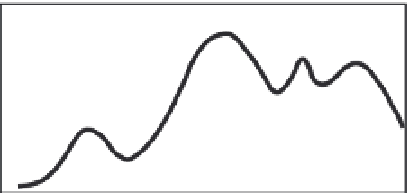Geology Reference
In-Depth Information
i.e., that after sampling
n
random boulders one
would record the same maximum diameter,
even though
n
is relatively small. Bull's (1996)
revision of the technique retains all the
population statistics and builds up a dense
histogram (probability density function) of the
lichen diameters. This approach is facilitated by
the availability of low-cost digital micrometers
whose resolution is high, and from which the
digital data can easily be exported as an
electronic file. Bull has applied his technique
in several settings, recording thousands of
measurements, and developing impressive
statistics. He calibrates his growth-rate curve
using surfaces that are independently dated,
often on the basis of tree-ring counts. From the
resulting distributions of maximum lichen
diameters, he argues convincingly that one can
resolve discrete events in the record that are
separated by a few decades or even less. Most
interestingly, and most pertinent to our topic,
Bull argues convincingly that he can resolve
discrete pulses of rockfall material associated
with seismic activity, at sites in both California
(Bull, 1996) and New Zealand (Bull and
Brandon, 1998). At the rockfall sites in California,
the composite probability density plots of lichen
diameters (Fig. 3.6) revealed several peaks,
which, when calibrated using the tree-ring dated
sites, correspond to historical Sierra Nevada and
San Andreas earthquakes within a few years.
Importantly, the breadths of the distributions
allow assignment of error estimates, which in
this case are ±3-10 years: a remarkably small
error for ages on the order of hundreds of years,
given that the clock is a biological one.
As in all techniques, limitations and
uncertainties exist. Here the proper climate is
required in which a well-behaved lichen thrives,
and one must be able to obtain independent
ages on surfaces for use in calibrating the
growth-rate curve. The biology behind the
method has recently been addressed by Loso
and Doak (2005). They remind us that lichens in
fact die. The components of a biologically sound
model include the colonization of the surface
we wish to date, the growth of individual thalli,
and the probability of death. Combination of
these essential ingredients gives rise to a
Calendar Date
1900
1800
1700
15
A
Knapp's Rock
King's Canyon
10
5
1872
0
5
10
15
20
25
30
Lichen Diameter (mm)
Use of Lichenometry to Date Earthquakes
Calendar Date
1800
1900
B
Middle Brother
10
5
1860
+ 10
1812
+ 10
0
5
10
15
20
Lichen Diameter (mm)
Fig. 3.6
Rhizocarpon
lichen diameters on talus
boulders in the Sierra Nevada, California.
Histograms (probability density functions) of diameters
record times of generation of new talus blocks,
corresponding to major historical earthquakes in
California. A. Lichens in King's Canyon. B. Lichens at
Middle Brother. Modified after Bull (1996).
modeled evolution of the population statistics
(essentially the demographics of the population).
They show that the demographic evolution
depends upon the individual species, in that
they will differ in one or another of the biological
components (Fig. 3.7). They also demonstrate
that other population statistics are more robust
as a measure of surface age than is the maximum
diameter - although, of course, such information
is much more difficult to document.
Some studies (e.g., Porter, 1981) have
suggested that lichen growth rates may be
higher on fine-grained volcanic substrates than
on coarser-grained intrusive rocks, whereas
other studies conclude that lithology, smoothness
of the substrate, local mean annual temperature,
precipitation, and length of the growing season
apparently do not exert a strong influence on





























































